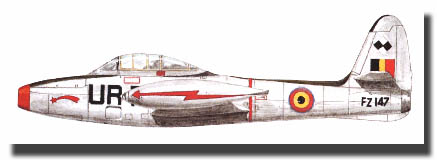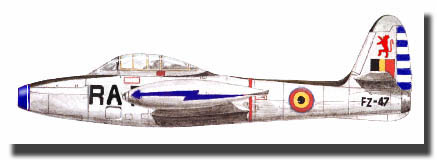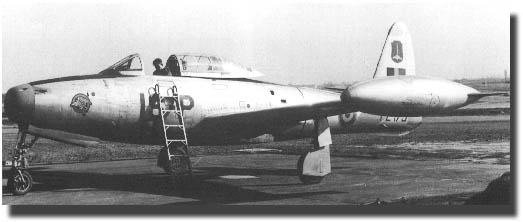Republic F-84 E/G Thunderjet
 The Thunderjet does not belong to those iconic aircraft that shape an era like the Spitfire or later the Starfighter. But nevertheless proves itself by serving year after year in practically all NATO countries, Yugoslavia, Thailand, Iran, etc.
The Thunderjet does not belong to those iconic aircraft that shape an era like the Spitfire or later the Starfighter. But nevertheless proves itself by serving year after year in practically all NATO countries, Yugoslavia, Thailand, Iran, etc.
The F-84G is the primary strike aircraft between 1950 and 1953 during the Korean war.
The F-84G was the first jet aircraft capable of delivering a nuclear weapon.
A F-84E at the Melsbroek Airshow July 13, 1952
The model of the Thunderjet fuselage seems to be pinched in the middle. Without realizing it at the time the engineers use an aerodynamic law resulting in a lower drag. No doubt this contributes to the success. Anyway it provides the engineers knowledge they later use to design the better known F-84F Thunderstreak.
The Korean war makes all western governments extremely nervous. Everywhere decisions are made to speed up the plans to modernize their armed forces. To maintain the same level in all countries of the Atlantic Partnership the American Congress approves a military aid program: M.D.A.P. (Mutual Defense Assistance Program). This is a kind of leasing program already used once during the Second World War.
Within the framework of MDAP the Belgian Air Force’s 2nd Wing receive the first F-84E bombers starting 1951. As of September 1952 the Spitfires of the 10th Wing are replaced by the recently delivered F-84G, a enhanced version of the E-type.
Starting August 1955 the F-84E/G’s are replaced by F-84F Thunderstreaks according the MDAP agreement.
The Belgian Air Force receives 21 F-84E (codes FS1-FS21) and 213 F-84G (codes FZ1-FZ213).
Technical Specifications
Republic F-84E/G Thunderjet
| Span | 11,09 m / 12,65 m |
| Length | 11,61 m |
| Height | 3,83 m |
| Engine | Allison J-35-A-17/29 with 2.268/2540 kg thrust |
| Maximum speed | 1001 Km/u - 540 Kts |
| Ceiling | 12.340 m - 40.485 ft |
| Range | 3.220 km - 1.739 Nm |
| Weight | 10.670 kg - 23.523 Lbs |
| Armament | 6 Browning .50 machine guns (4 in the nose and 1 in each wing), 32 H.V.A.R. 127mm rockets, bombs and rockets to a weight of 1.814 kg. |
Color Scheme's
The F-84E and G are bare metal bearing USAF registrations at arrival. The first couple of months the aircraft keep flying with these registrations even without Belgian emblems or registrations. These aircraft only have olive drab anti glare panels on top of the fuselage.

F-84E Thunderjet, 2nd Wing, 1951
After a short while, the USAF markings are removed and replaced by squadron codes, serial number and cockade’s. Depending on wing and squadron the nose, tip tanks and tail are decorated with squadron colors and wing insignia.

F-84G, 2nd Squadron, 2nd Wing, Florennes, 1954

F-84G, 27th Squadron, 10th Wing, Kleine-Brogel, 1954

Code IS: a Thunderjet of the 22nd Squadron, 9th Wing, Bierset, 1953
 NL
NL  EN
EN 


